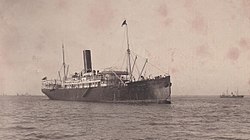Carlos de Eizaguirre
|
||||||||||||||||||
|
||||||||||||||||||
|
||||||||||||||||||
|
||||||||||||||||||
The Carlos de Eizaguirre (ex British Landana ) was a Spanish passenger steamer that was sunk on May 26, 1917 off Cape Town by a mine of the German auxiliary cruiser Wolf . It was one of the worst shipping accidents in Spanish merchant shipping during the First World War .
Activity until 1917
The Landana was as Leopoldville for a Belgian Africa -Reederei on keel laid, but apparently still on the slipway to the London African Steamship Company sold and promoted as Landana put into service. Nothing is known about their use; presumably it was used in West Africa traffic , the company's division. The Landana was sold in London on November 4, 1910, presumably due to the dissolution of the company in 1909, to the Compañia Transatlántica (CT) in Barcelona, which renamed it Carlos de Eizaguirre .
After renovations, she left on March 21, 1911 for her first liner trip to Manila ; a route that has been used by the CT since the 1870s. The route led from Cadiz via Barcelona, Genoa , the Suez Canal , Colombo and Singapore to Manila and back.
The misfortune
Due to the First World War, the Suez Canal was closed to non-allied merchant shipping by the British authorities in Egypt . Since Spain remained neutral during the war , Spanish ships were forced to take the detour via the Cape of Good Hope in traffic with East Asia , where Cape Town was used as a coal station.
On April 21, 1917, the steamer ran under Captain Fermín Luzárraga Learreta (born February 2, 1862 Busturia ) with a total of 104 crew members and 19 passengers from Barcelona and arrived in Cadiz on April 26. On April 30th she called at Las Palmas . There she ran out on May 5, 1917 with the destination Cape Town. In the meantime, some passengers had been disembarked and others had been embarked.
On May 26th, at 3:30 am, the steamer between Robben Island and Cape Town at position 33 ° 46 'south, 17 ° 59' east was shaken by a severe explosion. This position was subsequently determined by the port authorities in Cape Town. The Carlos de Eizaguirre broke in two and sank in four to five minutes. There was darkness, rain and heavy seas . 24 castaways managed to man a lifeboat under the leadership of 2nd officer Luis Lazaga Gómez . In the short term threatened the still rotating propeller to smash the boat sinking eight ships, but managed Lazaga to break free and to sail Cape Town. Shortly before arriving in port, the boat was picked up by a tug and arrived in Cape Town at noon on May 26, 1917.
The auxiliary machinist Alejandro Fernández had not been able to reach the lifeboat. However, he was able to hold on to a piece of debris from the wreck that served him as a makeshift raft . He drifted at sea for thirteen and a half hours before he could be recovered by the coastal boat Langebaan under the command of Captain Odde.
The castaways were taken care of in the Sailor's Home in Cape Town . On May 27, a mourning ceremony was held in Cape Town in honor of the victims. The sinking of the ship had cost the lives of 134 people (50 passengers and 84 crew members). These included 12 women and 5 small children. In the following days, eight bodies were washed ashore in the Cape Town area, which could be identified as passengers or crew members of the steamer.
A mine explosion was ultimately assumed to be the cause of the accident. According to a non-official statement by the port commander of Cape Town, five mines had already been found in the port. However, the find was kept secret by the British government in order not to prevent neutral shipping from calling at the port. The company had been informed anonymously that the Carlos de Eizaguirre was the fourth ship to have disappeared under mysterious circumstances near Cape Town. Finally, it was found that the mine came from the German auxiliary cruiser Wolf , who had put a mine lock off Cape Town on the night of January 17, 1917 on its way to the East Asian operational area .
literature
- Fernando José García Echegoyen: Naufragio - Crónicas del mar y la muerte (Shipwreck - Chronicles of the Sea and Death), Málaga 1993.
- Julio Molina Font: Cadiz y el vapor-correo de Filipina's "Carlos de Eizaguirre" (1904-1917). Historia de un naufragio. (German Cadiz and the Philippine mail steamer "Carlos de Eizaguirre" (1904–1917). History of a shipwreck ), 2. Erw. Edition Cadiz (Universidad de Cádiz) 2007. ISBN 978-84-9828-119-4 .
- Fritz Witschetzky : The Black Ship , Stuttgart 1921.
Web links
- Photo by C. de Eizaguirre [1]
